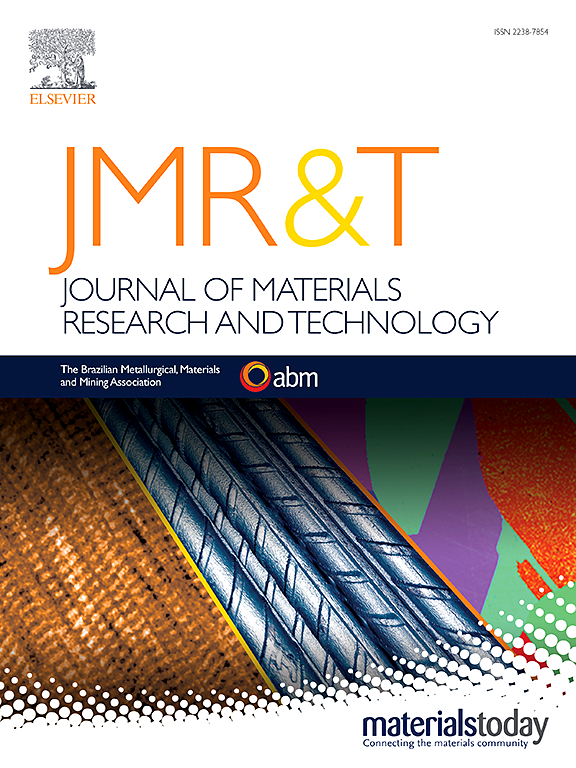微晶玻璃磁流变抛光多阶段工艺优化及效率提高
IF 6.2
2区 材料科学
Q1 MATERIALS SCIENCE, MULTIDISCIPLINARY
Journal of Materials Research and Technology-Jmr&t
Pub Date : 2025-06-05
DOI:10.1016/j.jmrt.2025.06.034
引用次数: 0
摘要
磁流变液组成(MFC)和工艺参数对磁流变抛光微晶玻璃的效率和质量有重要影响。本研究采用单因素实验确定最佳MFC。通过纳米压痕实验,分析化学作用下材料的去除特性。采用响应面法(RSM)对工艺参数进行优化。最后,将优化后的参数应用于多阶段MRP过程。结果表明,最佳MFC为:抛光时间为60 min,磨料为氧化铈,粒径为1.5 μm, pH = 9。化学作用降低表面硬度,从而提高材料去除率(MRR)。RSM构建的预测模型具有较高的信度,R2为0.9745。采用最佳MRR参数(工件速度800 r/min,圆盘速度90 r/min,工作间隙2 mm,偏航速度120 mm/min)进行抛光20 min,然后采用最佳表面粗糙度(Sa)参数(工件速度400 r/min,圆盘速度90 r/min,工作间隙2.4 mm,偏航速度80 mm/min)进行抛光24 min。MRR为0.716 μm/min, Sa为2.423 nm。与单段抛光相比,多级抛光效率提高26.7%,成本降低。为MRP微晶玻璃的发展提供了新的技术支持。本文章由计算机程序翻译,如有差异,请以英文原文为准。
Multi-stage process optimization and efficiency improvement for magnetorheological polishing of glass-ceramics
The magnetorheological fluid composition (MFC) and process parameters significantly affect the efficiency and quality of magnetorheological polished (MRP) glass-ceramics. This study employed a single-factor experiment to determine the optimal MFC. Nanoindentation experiments were conducted to analyze material removal characteristics induced by chemical action. Response surface method (RSM) was utilized to optimize the process parameters. Finally, the optimized parameters were applied to the multi-stage MRP process. The results show that the optimal MFC as follows: polishing time is 60 min, abrasive is cerium oxide, particle size is 1.5 μm, and pH = 9. Chemical action reduces the surface hardness, thereby increasing the material removal rate (MRR). The prediction model constructed by RSM showed high reliability with an R2 of 0.9745. The polishing process was carried out for 20 min using the optimal MRR parameters (workpiece speed 800 r/min, disc speed 90 r/min, working gap 2 mm, yaw speed 120 mm/min), followed by 24 min using the optimal surface roughness (Sa) parameters (workpiece speed 400 r/min, disc speed 90 r/min, working gap 2.4 mm, yaw speed 80 mm/min). This resulted in a MRR of 0.716 μm/min and Sa of 2.423 nm. Multi-stage polishing improved efficiency by 26.7 % and reduced costs compared to single-stage polishing. It provides a new technical support for the development of MRP glass-ceramics.
求助全文
通过发布文献求助,成功后即可免费获取论文全文。
去求助
来源期刊

Journal of Materials Research and Technology-Jmr&t
Materials Science-Metals and Alloys
CiteScore
8.80
自引率
9.40%
发文量
1877
审稿时长
35 days
期刊介绍:
The Journal of Materials Research and Technology is a publication of ABM - Brazilian Metallurgical, Materials and Mining Association - and publishes four issues per year also with a free version online (www.jmrt.com.br). The journal provides an international medium for the publication of theoretical and experimental studies related to Metallurgy, Materials and Minerals research and technology. Appropriate submissions to the Journal of Materials Research and Technology should include scientific and/or engineering factors which affect processes and products in the Metallurgy, Materials and Mining areas.
 求助内容:
求助内容: 应助结果提醒方式:
应助结果提醒方式:


